What you need to pay attention to when building
The site on which the structure will be erected must be absolutely flat.

You can check this using a level. It can be concreted, covered with rubble, tiled, etc.

Metal, stone, brick are suitable as materials for supports, and wood, plastic for the roof. when choosing wood, it is necessary to check how well it has dried and has been treated with an antiseptic and fungicidal composition.

During operation, the impregnation will need to be repeated several times.

The optimal height of the structure is 2.3-2.5 m. Be it lower, it will be inconvenient to pass through it, higher, wait a long time for it to overgrow. The length can be any.

The highlight of any pergola is the plants that envelop it and turn it into a green corridor.

As a rule, these plants are curly: bindweed, ivy, maiden grapes, wisteria and others.

In resort towns, each owner uses a pergola as a support for grapes. And now it is bred in Central Russia, and even in Siberia.


Topical tips for competent construction of pergolas
In a well-organized landscape design, the pergola should be harmoniously combined with the nearby buildings and ideally "fit" into the overall design idea. In order not to fragment the unity of style and maintain the combination of the structure with the surrounding space, it is necessary to strictly follow the basic nuances during construction:
- the weight of the structure should not be large. Regardless of the type of materials used in construction, light rays must penetrate inside without hindrance;
- high-quality decoration elements are a sure guarantee of a year-round great mood. In the spring and summer, all design flaws will be masked by the foliage of the plants. But, unfortunately, in autumn and winter the building will be completely "bare". Therefore, even small installation work should be done scrupulously and accurately;
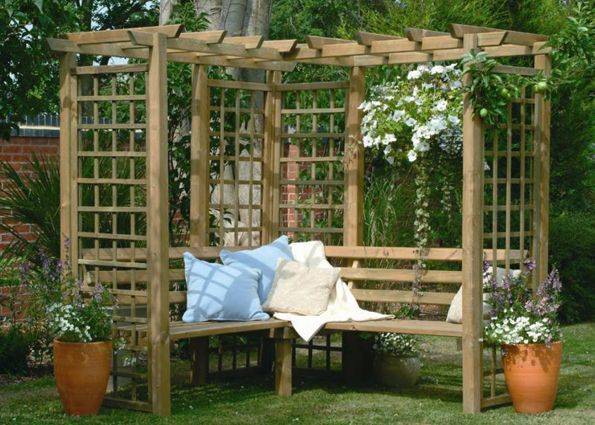
- qualitatively measure the parameters of the structure and the size of the site. It is unacceptable that the structure is lost in the elements of the landscape. However, it should not occupy a large area of the territory, especially when the land plot is not very large;
- when metal or wood is chosen as the predominant building material, you should remember about the obligatory regular protective treatment. The wood is impregnated with special antiseptics, and the metal is treated with high-quality anti-corrosion compounds;
- the created building must necessarily have good strength, since the plants, growing, gain considerable mass.
With strict observance of the above recommendations, the constructed structure will stand for a long time and will delight its owners every year.
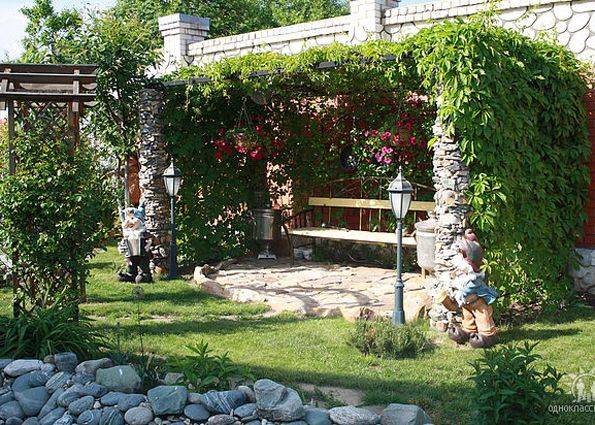
Pergola in landscape design
The idea of using pergolas in landscape design was borrowed from the Spaniards and Italians. They erected structures with lattice roofs to facilitate their harvesting of grapes. But hiding from the hot sun under the shade of green foliage was no less pleasant. It's no surprise that designers started using pergolas in their designs. What they are and why they are needed, we will tell you in this article.
What is a pergola and why is it worthy of becoming a part of your garden
The pergola is a frame with a lattice roof, the slats of which are entwined with climbing plants. This design looks original and beautiful, helping to give the appearance of a suburban space the necessary features, depending on the tasks of the project.
Aesthetics is not the only reason why designers turn to this kind of small architectural form. Pergolas are used for:
improvement of a comfortable recreation area. Of course, they will not protect from the rain, but completely from the scorching sun.A special microclimate, in the creation of which vegetation plays the main role, is noted by almost everyone who has ever been under a trellised canopy. What will be here - a lonely standing bench for seclusion or an outdoor dining room - you decide;
zoning of the territory. In this case, the narrow pergola resembles a portal that connects the various zones. At the same time, it combines garden elements, bringing harmony to the atmosphere of the garden. The main thing is that the design of the building coincides with the general landscape concept;
camouflage of utility rooms. Lush vegetation can hide unsightly outbuildings
The original appearance of the pergola can also divert attention from them;
creating a "green" corridor. Walking along the path, on which the shadows of the bindweed or the girl's grapes twisting the crate are cast, will become your favorite pastime;
vertical gardening
Climbing roses, clematis and other climbing plants need support. The frame and crossbars on the roof just serve as the basis for their growth and development;
decor of the entrance area. The design allows you to focus on the gate and bring originality to the look of the garden.
Form and types of structures
Choosing a pergola for landscape design is not an easy task. To begin with, you have to decide on its appearance.
- A visor is an option for those who do not have a large area of a suburban area. In this case, the canopy adjoins the cottage from the sunny side. Simultaneously with the creation of a cozy recreation area, the problem of shading the windows in the house is being solved.
- Screens and trellises. In fact, these are trellis structures that serve as a support for the growth of climbing crops. In this case, the trellises are usually attached to a vertical base: a wall of a house or a retaining wall. The screen, consisting of several sections, is installed directly on the ground and is suitable for creating private areas in the back of the garden.
- Awning. The spectacular canopy is suitable for many tasks: from dividing the site into functional zones to protecting the playground from the scorching sun. The main thing is to decide on the size of the structure so that it is commensurate with other garden elements.
- Tunnel. This type of pergola is suitable for owners of large areas who want to walk along paths sheltered from the sun.
There are also pergolas in shape. The smooth lines of the round structures give the site softness and lightness. The rectangular frame looks more graphical, thanks to which it fits favorably with modern landscape design styles.
Specialists also pay attention to the development of the upper overlap. You don't have to make it flat
If the design concept requires rounded, smooth outlines, then you should opt for an arched crate.
Modern technologies make it possible to create pergolas of complex shapes. An imitation of a sail, a Chinese tea house may appear on your site if you turn to professionals. A designer interested in the aesthetics and uniqueness of the project is able to offer more non-trivial options.
Types of pergolas for summer cottages
Depending on the design
Canopy
The traditional pergola design is a conventional canopy. Most often - with support on any wall (house, barn, fence, etc.), on the other hand, it is supported by columns. The main task is to protect from the sun.
Separate building
A free-standing structure with a platform (flooring) and arches abutting against it. Almost a gazebo. In addition to the protective function, an aesthetic one is added. It is used in landscape design more often than a regular canopy.
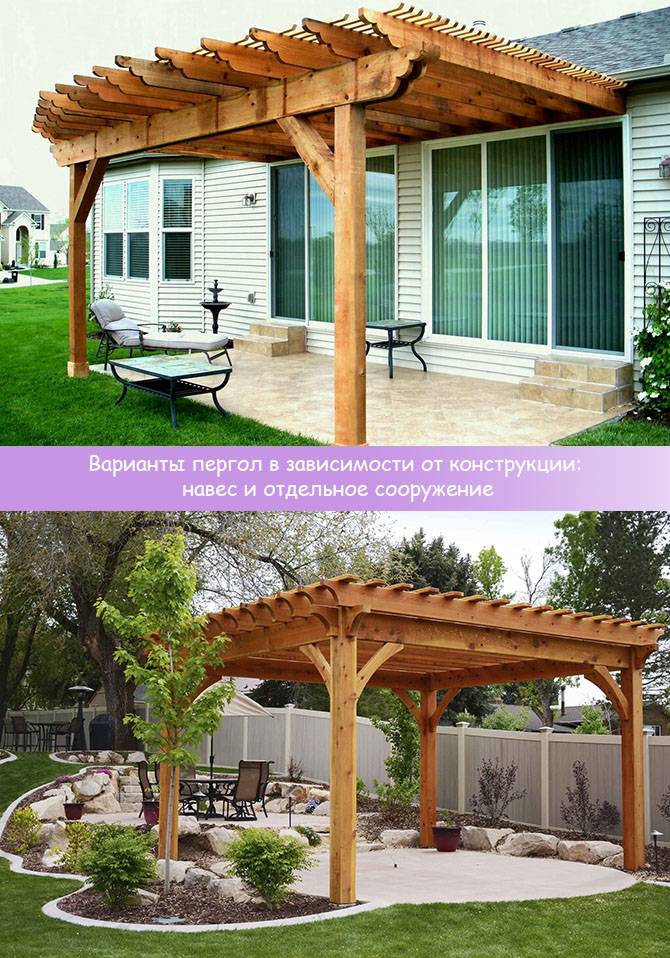
Depending on the type of canopy
Traditional
The canopy is designed as a traditional square or rectangle.
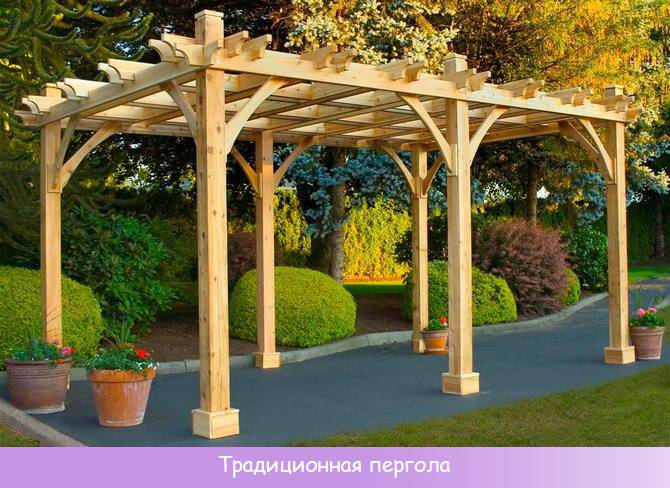
Pointed
The canopy can be designed like a traditional roof of the house. This element can be used to combine with the design of the cottage (make them the same).
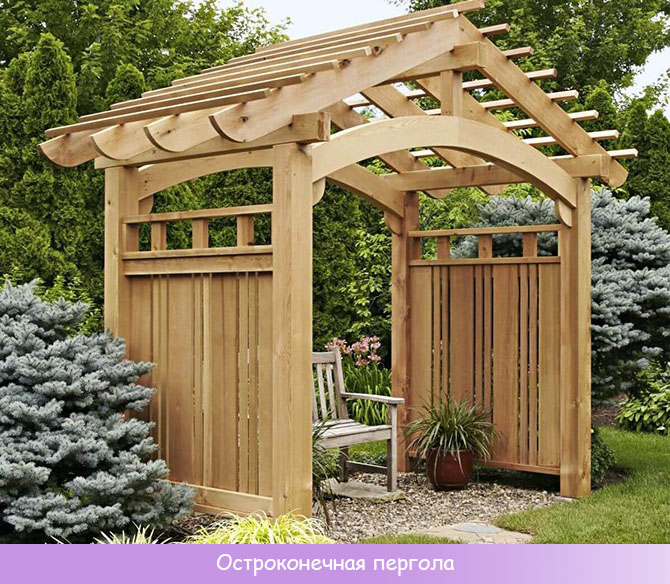
Arched
The most popular type of canopy in landscape design, since it is it that allows you to use the largest number of ornamental plants. In this case, they can be launched not only along the walls, but also on the roof.The basis of this design is a semicircular arch.

Promenade
Walking pergola, a kind of arched. They put several repeating arches, connect them with transverse beams, and they create a kind of shaded gallery, alley. Most often, such a structure is erected to move from one building to another or to decorate an exit.
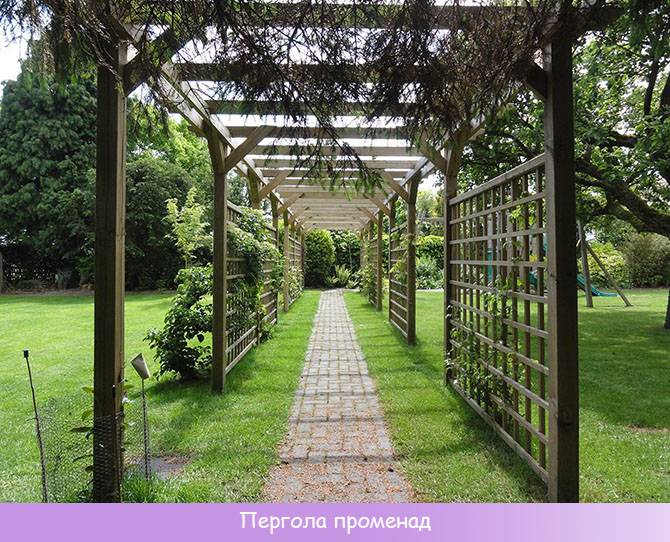
Inclined
If you want the sun to come to visit at certain hours, the canopy is made inclined.
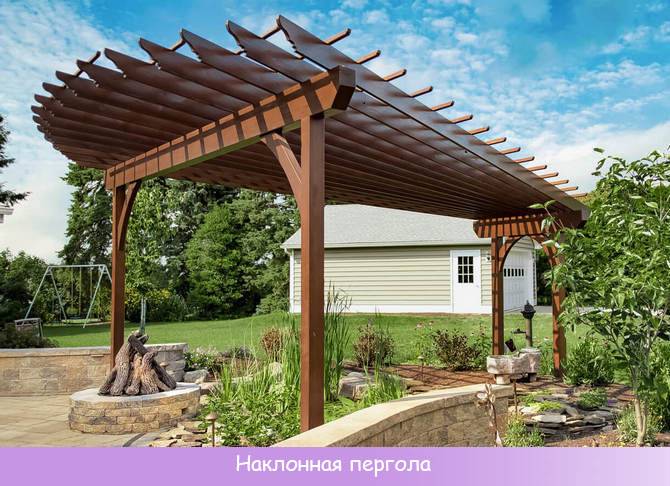
Depending on the shape
Like the canopy, the pergola itself can be of different shapes: traditionally rectangular (for pleasant gatherings) or elongated (for walking). Modern trends can offer more original options:
- in the Japanese style (wooden pagoda) - a pyramidal roof with concave edges and decorative openwork elements;
- round (rotunda, geo-dome, yurt, igloo, wigwam) - one of the most original, but complex and expensive structures to build;
- corner - an easy and practical option, which is usually erected in the far corner of the site or next to the house (leaning on one of its walls).
So the shape of the structure can only be limited by the imagination of the owner of the site.
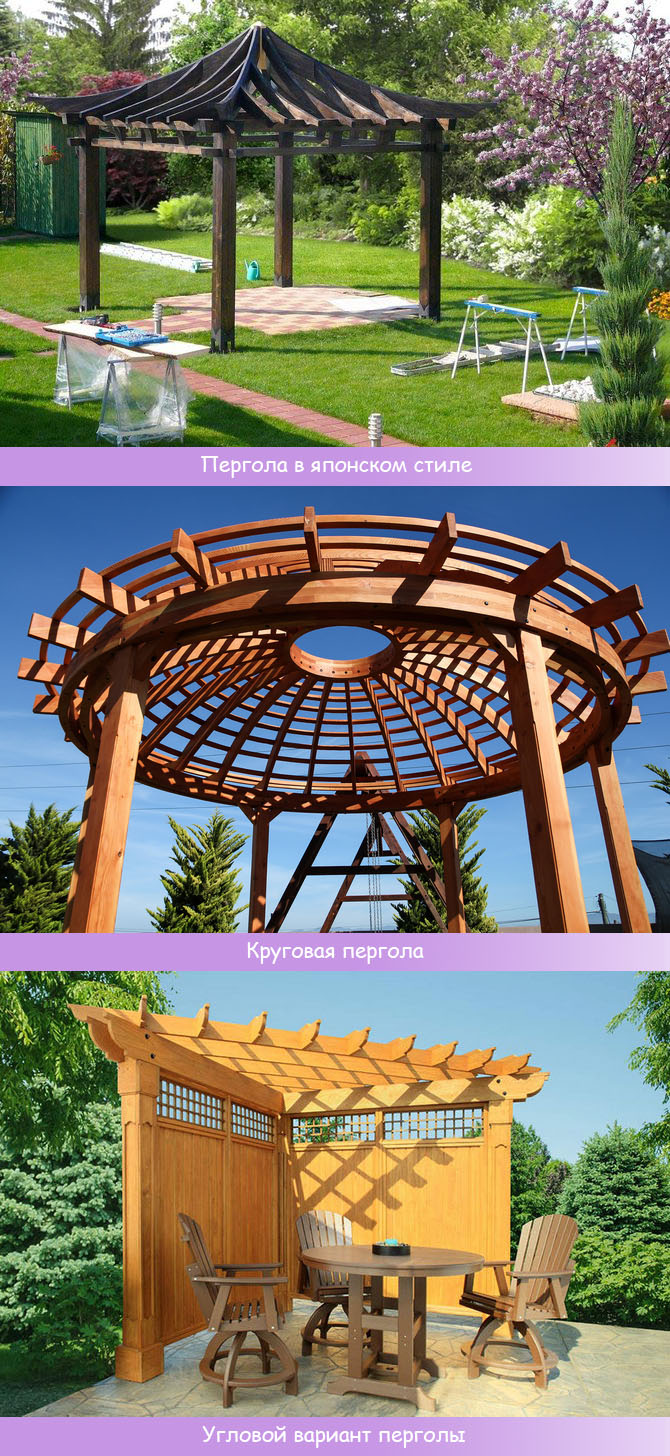
Depending on the style
Pergolas have been a trend for several seasons in a row. They are in great demand. And, in order to meet the needs of buyers, manufacturers are trying to create different style options:
- country - regular geometric shapes with minimal decoration;
- hi-tech - the most unusual forms (in the form of a spacecraft or a scientific laboratory) + equipment with the latest technology (electric bracelet, heated floor, sofas in the form of a cloud, etc.);
- modern - clear lines, high functionality, contrasting combinations;
- east - luxury, red-brown colors, lanterns, carpets, ornaments, made of wood or bamboo;
- chalets - eaves, reliability, comfort, the obligatory presence of a barbecue, fireplace or even a stove;
- fachwerk is a practical frame construction made of high quality materials.
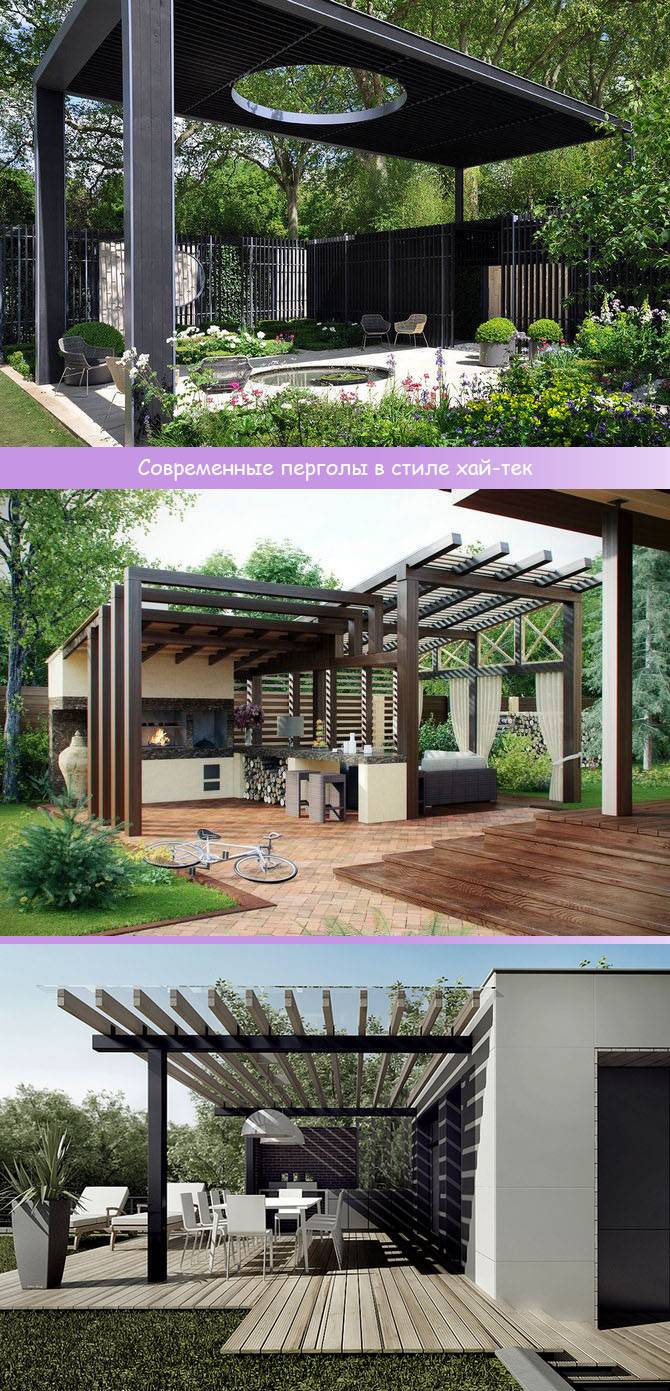
Depending on the material
The traditional wooden pergola has recently become worthy competitors. A variety of materials are used for its construction:
forged structures are durable and delicate, but they require the hands of a real master and cost a lot of money;
metal - beautiful, stylish, modern, practical ("forever", as they say), but heavy and require a full-fledged foundation;
stone - designer, massive, attracting attention, become the central point of the site, therefore, they are usually erected in parks and gardens of a large area;
plastic - lightweight, prefabricated, budgetary, cleaned for the winter, are unstable and impractical;
combined - a combination of different materials in one design.
Photo:
If on sites mainly a garden pergola is used, then its urban version is used in parking lots and playgrounds (in the form of a simple awning or visor).
If you have children, you should definitely take a closer look at the canopies with swings:
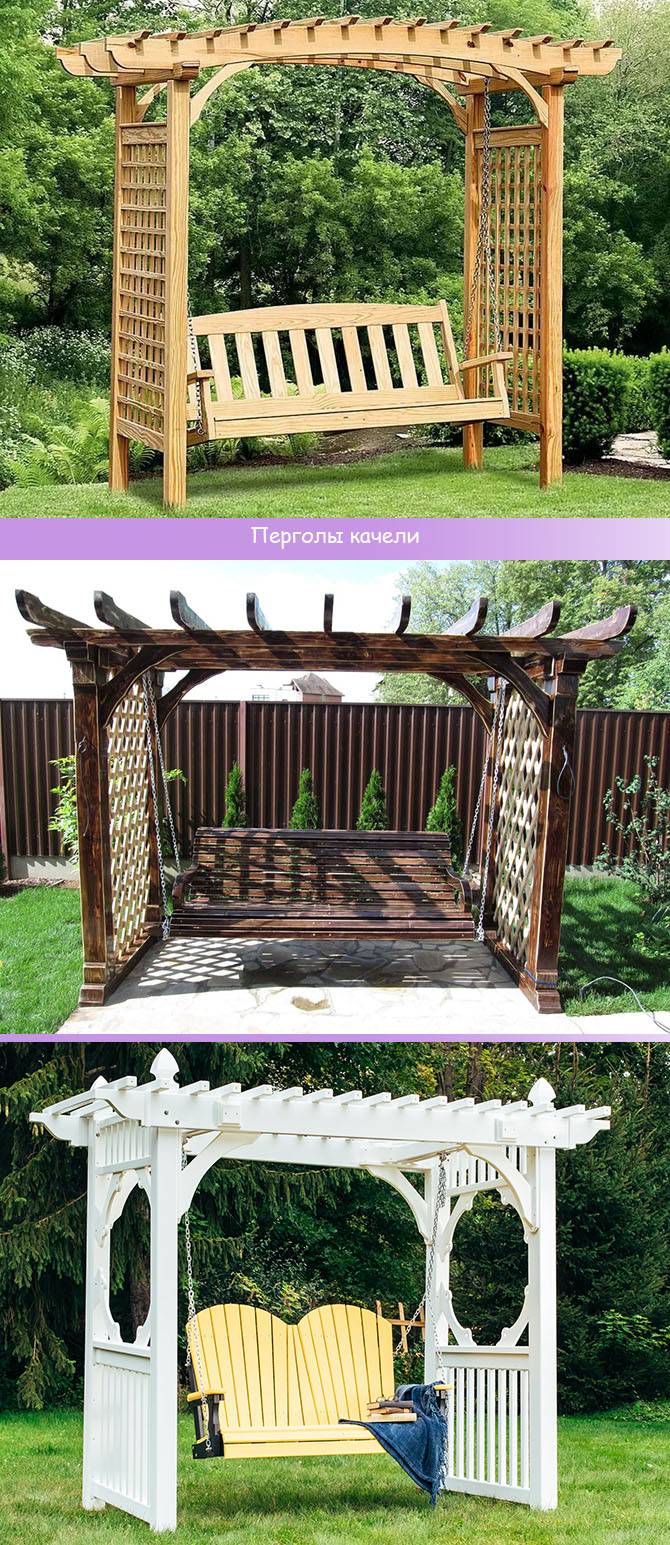
Pergola styles
If the old pergolas were pretty monotonous, now you can decorate it in any style. Here are some options for inspiration: - Classics. This is a strict and discreet frame made of beams with lattice overlap. Minimalistic and elegant at the same time. And if you want to add modernity, take metal instead of wood. - Rustic style. Simplicity, naturalness and deliberate rudeness are in fashion. The aged wooden beams on massive pillars seem to have left the pages of fairy tales and legends. And the more the greenery grows, the stronger this effect. - Palace style. It is power and luxury.Massive columns with forged inserts, stone elements and arches, monumental pillars, powerful vines and weaving rose bushes will set the right mood. - Oriental style. Elegant, lightweight, openwork designs are especially good from precious wood or bamboo. But keep in mind that this is more a decorative than a functional solution.
Where should the pergola be placed?
The location for the construction depends, first of all, on its purpose. Therefore, first you need to decide what role the pergola will play - it will be an addition for decorative elements, or it will be a support for plants, or it will still create a shadow like a gazebo or a canopy.
One of the most popular location options is a detached building above the dining and relaxation area. After all, having your own home, it would be a great loss not to have a special place for eating outdoors. Of course, such a building is not able to protect the dining space from the pouring rain, but it is quite capable of protecting it from the summer sun.
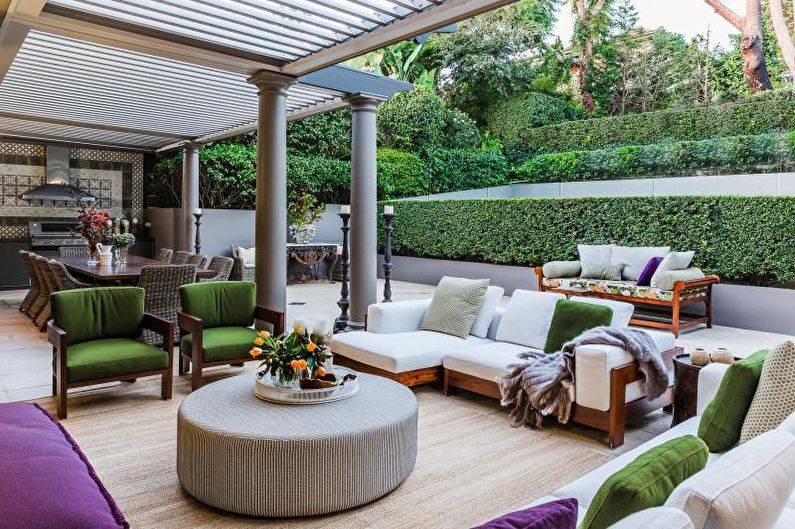
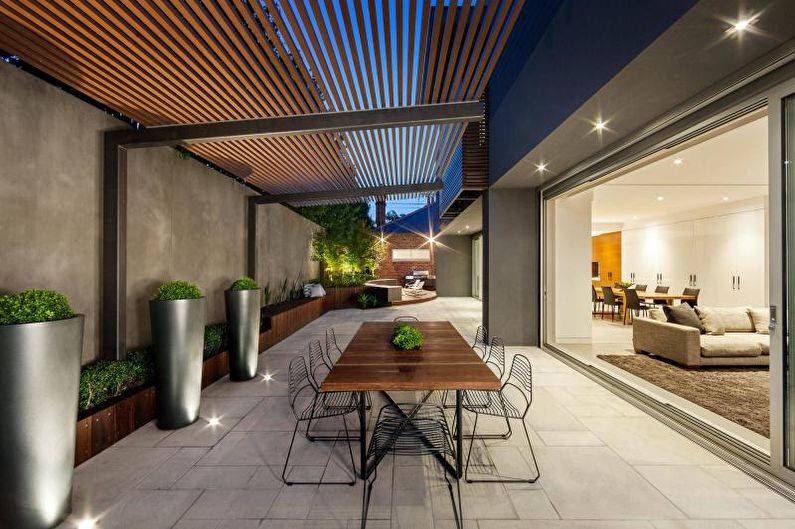

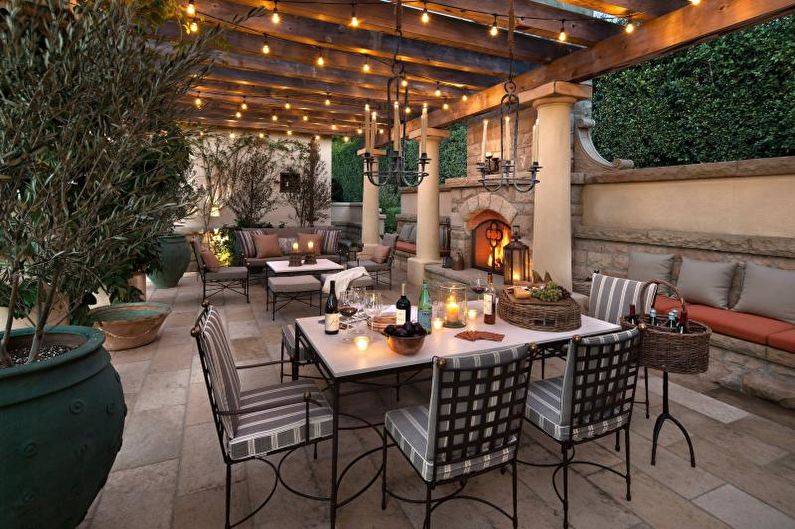
It is quite popular to install a pergola as building extensions... Often, the design involves a large visor, which allows you to form an area for eating right next to the dwelling. This is a fairly convenient and practical solution, and by the way, it is perfect for homeowners with a small land area.
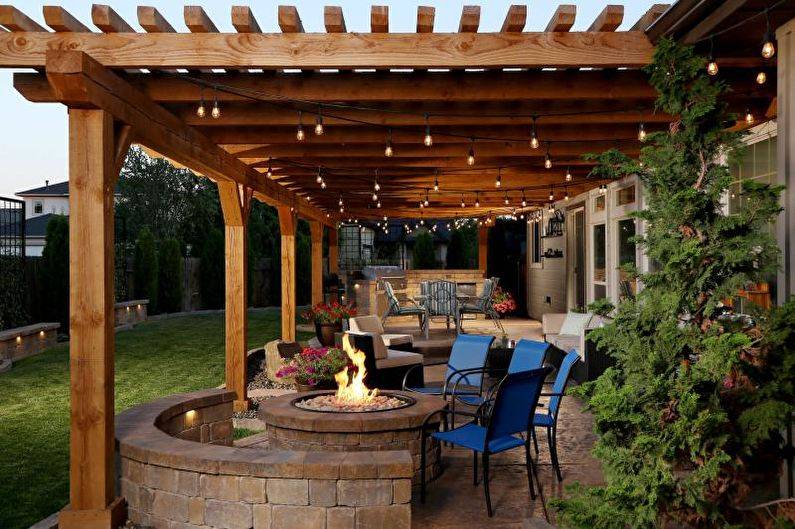
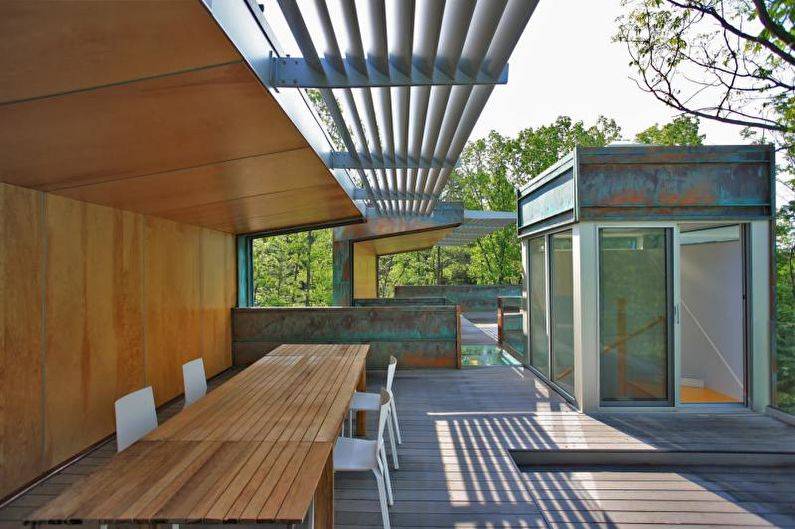

A specially designated area for B-B-Q will be an honor to any owner of a private house. The process of preparing food in the fresh air can be as enjoyable, if not more, than actually taking it. A pergola can not only darken a place for a barbecue or stove, but at the same time represent an exquisite component of landscape design.
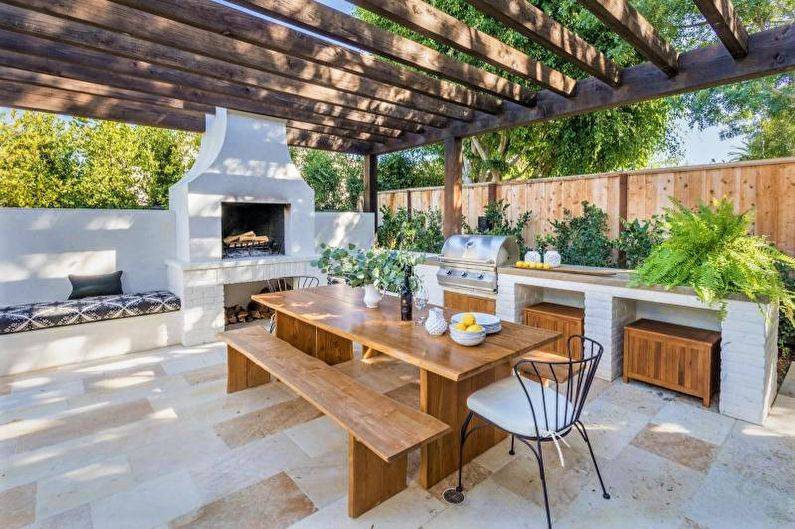
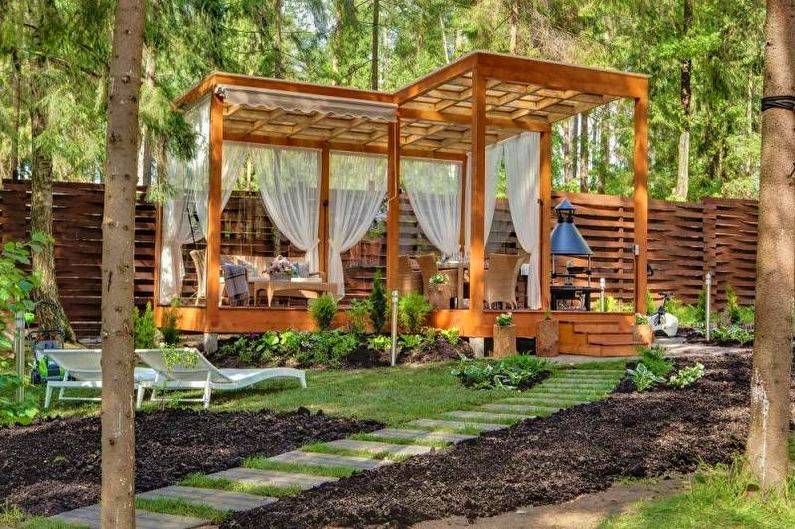

Place to rest near the pool also requires dimming. Even a small canopy can accommodate several sun loungers, trestle beds and even a small sofa. You will get the opportunity to relax by the water for a long time, without fear of getting burns and sunstroke. In addition, the pergola will provide unobstructed ventilation, which is not possible with a standard gazebo.
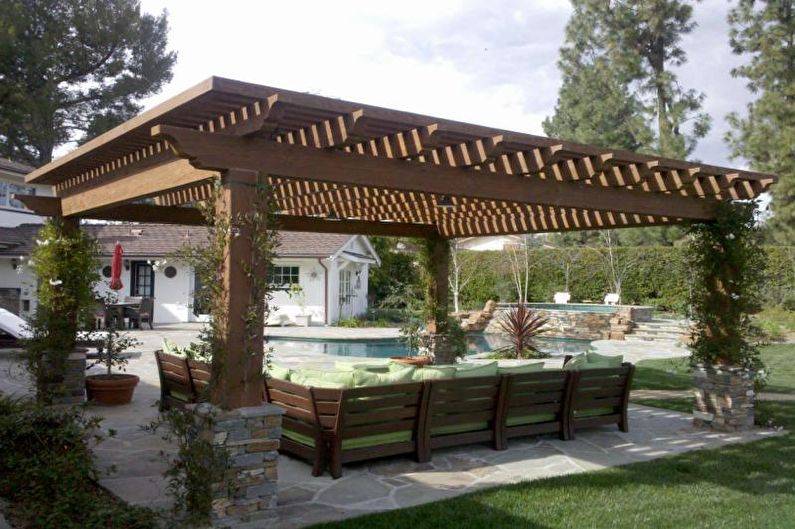
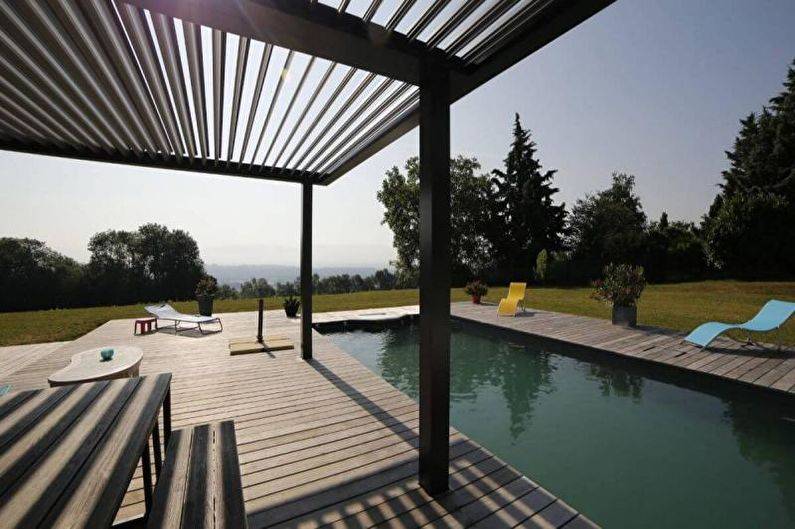
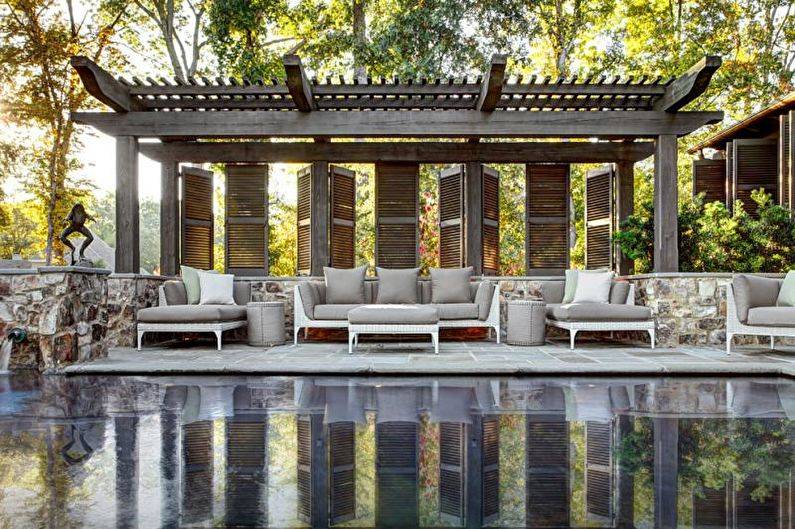
If you own a summer cottage, which is conventionally divided into several functional areas, then the pergola will be a good option for creating a decorative passage between them. The design will also create shade for plants that need it, a playground, horizontal bars and swings. Similar tricks are applicable to organizing a small backyard in an urban private household.

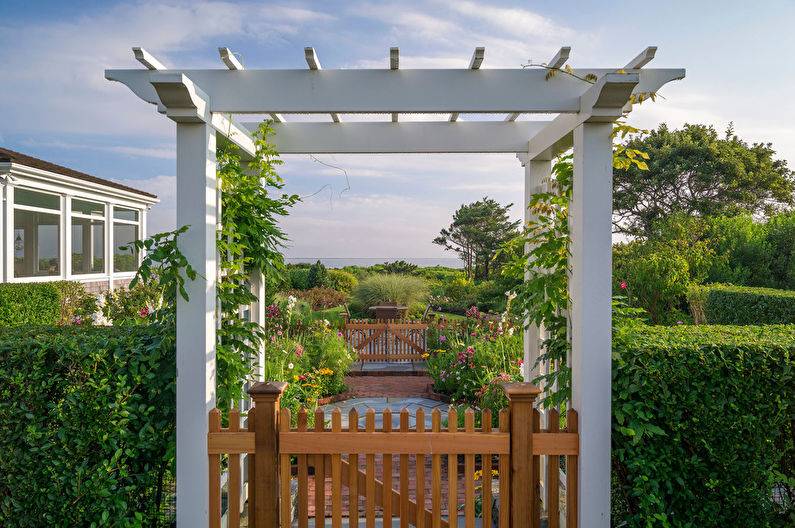
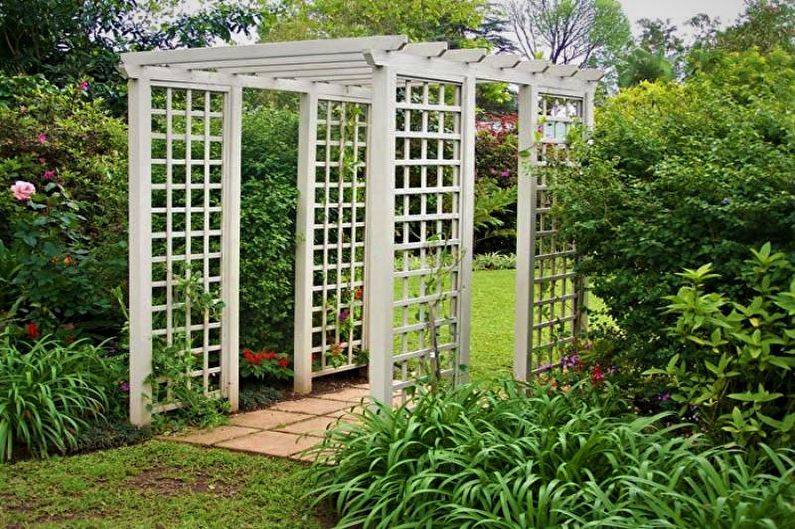
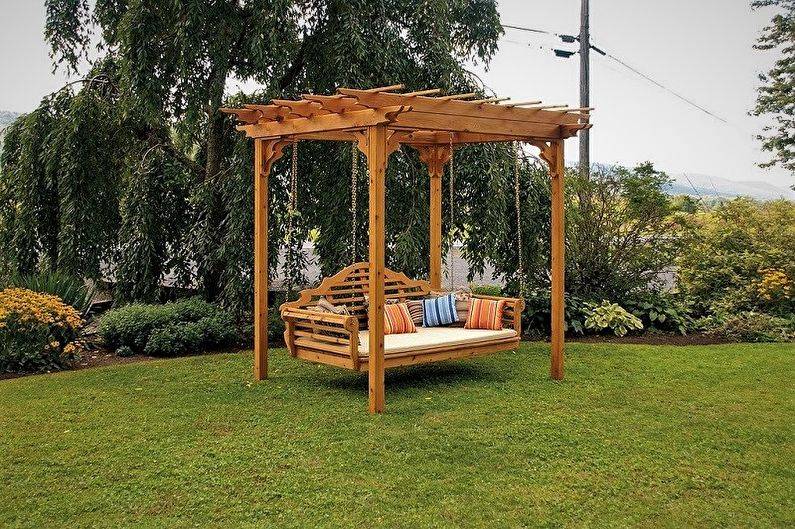
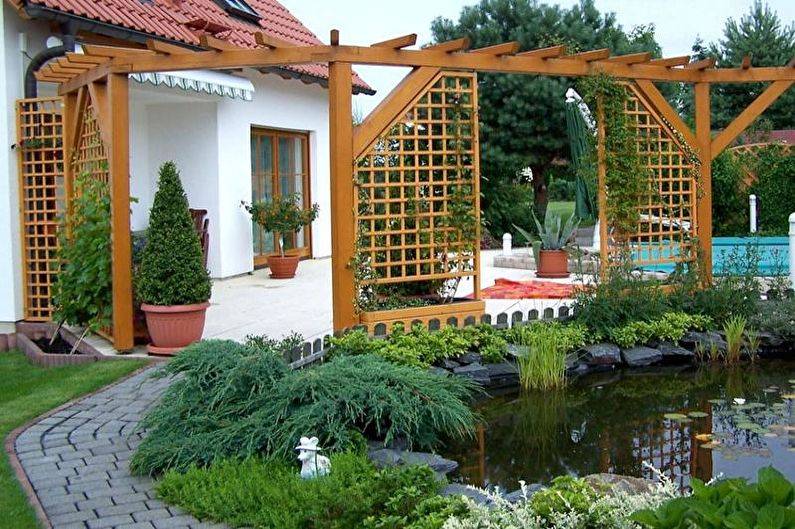
Among other things, a canopy can be an element balcony private house. If the loggia is located on the south or east side, then during the day the sun's rays will break through and heat the space not only on the territory of the balcony, but also in the rooms, which necessitates the formation of blackout. It will be provided by a durable, but lightweight and unobtrusive design. The appearance should organically fit into the overall idea of the stylistic and color scheme of all adjacent objects.
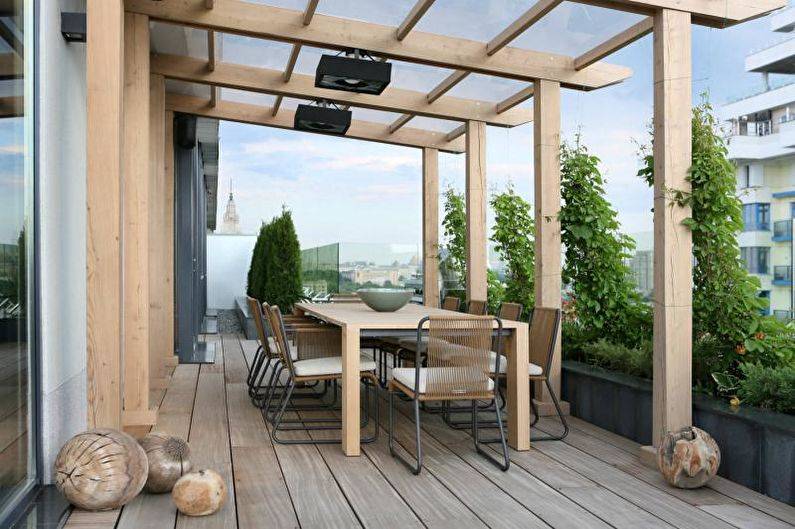
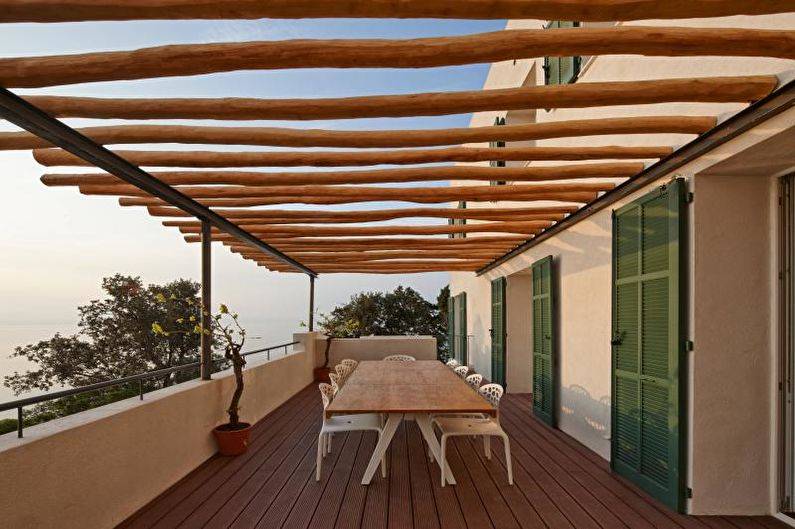
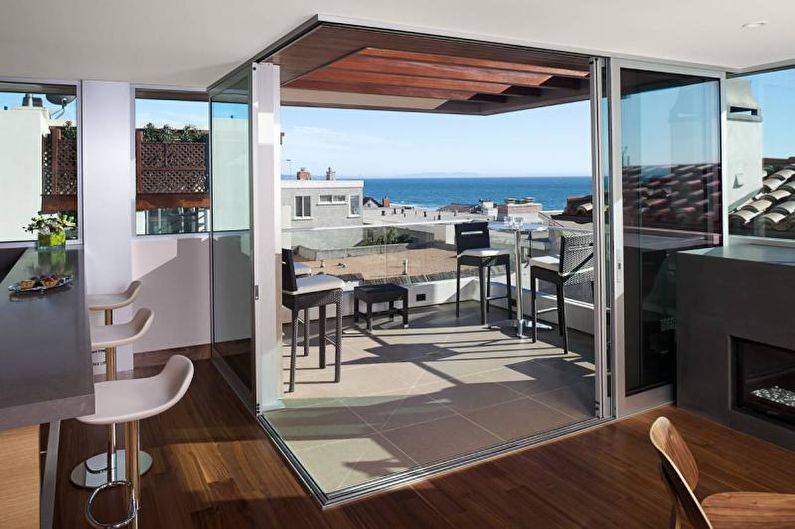
Garden arches: which plants are best for them
When choosing all kinds of plants for a pergola, it is better to opt for the active climbing representatives of the flora kingdom, while it is necessary to take into account the stability of the structure and its ability to endure certain loads.

Green ivy, cultivated or wild-growing grapes are optimal for decorating pergolas, varietal clematis and even honeysuckle are most often selected from flowers, but the most beautiful compositions are created with weaving roses of various varieties and sizes.

For protection from the sun, pergolas of various design solutions are installed in open areas of the local area or summer cottage, the ribbed roof of the structure provides free ventilation of the internal area of the building.
Thanks to actively growing greenery, vines or climbing plants, protection from rain is provided, arches without flooring are suitable for arranging inside not only a recreation area, but also an open hearth or a fountain.

DIY installation of a pergola
The features of the installation are greatly influenced by the type of material used and the type of pergola. Each design has its own approach to installation.
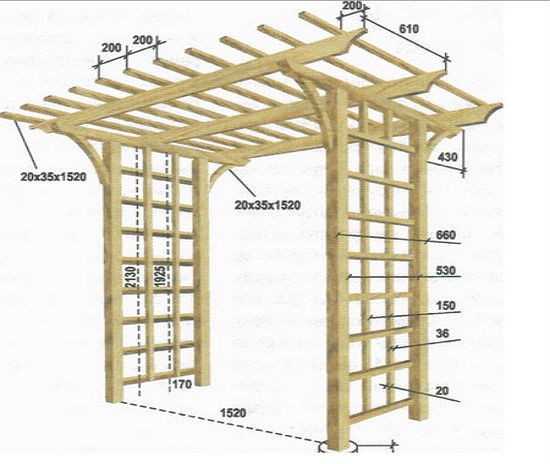
A classic pergola with your own hands can be made even by a person without construction experience.
It is done in three steps:
- fastening support pillars;
- installation of horizontal beams, on which the lathing will subsequently be attached;
- installation of the pergola roof.
Step by step instructions will give you how to build a pergola with your own hands.
To install the pillars on the ground, you will need metal thrust bearings, formwork molds, and concrete.
First you need to prepare the area where the pergola will be installed. The surface of the ground must be firm and level.
It is important to ensure that the mass is homogeneous and lies without voids, then a really strong base for the support pillars will be provided. Having leveled the concrete surface, you need to insert the lower part of the thrust bearing into the soft mass
This is how the bases for each pillar of the future pergola are prepared.
Having leveled the concrete surface, you need to insert the lower part of the thrust bearing into the soft mass. This is how the bases for each pillar of the future pergola are prepared.
There should be as many blanks as there will be pillars. The resulting structure should grab and harden, which may take several days, after which you can screw the support pillars to the thrust bearings with screws.
At the second stage, it is necessary to fasten the horizontal beams to the installed posts.
They can be simply placed on top, secured with screws, or used for additional fixation T- or L-shaped metal plates.
Video:
A groove made in advance in each pillar will help to fix the horizontal beams. If desired, the supporting elements can be reinforced with diagonal trims.
To do this, you need to take small beams and make cuts on them along the edges at an angle of 45 degrees, after which they need to be attached with screws on one side to the support post, and on the other to the horizontal beam.
Now you can install the lathing by placing beams or slats on top and fixing them obliquely with screws.
Using this universal instruction, you can improvise and create a pergola made of wood for a summer residence on a different number of support pillars.
Video:
In addition, the lathing can be laid out both in one and in several layers, which will give the structure a multidimensionality.
In fact, there are so many design variations and types of structures that you cannot find a single pergola in the photo in various magazines and catalogs.
Pergola in landscape design photo
In modern landscape design, a variety of plants are used, designs that allow you to give the area around the house a more attractive and interesting appearance. Recently, the pergola has become very popular. It is a lattice structure of an arched type, which acts as a kind of support for climbing plants. Thanks to her, it is possible to create a shadow in which you can enjoy your time. Most often, such designs are densely entwined with greenery, a variety of flowers grow there, which allows you to create a slightly magical and rather specific surroundings.

Modern pergola in landscape design, its photos and interesting features
Thanks to structures of this type, it is possible to create attractive gazebos that let in fresh air, the rays of the sun, but at the same time provide protection from the heat of the day. In such a place you can read, drink tea or other drinks and just relax.
In modern summer cottages and adjacent territories, such products are found more and more often, because they can be an ideal choice for zoning space and creating appropriate conditions for recreation.If you need to separate the decorative area of the site from the garden, you can use this product. They are often installed to shade walking paths that can lead from the house to various parts of the site, for example, a garden, an outbuilding, etc.
In order for the structure to fit perfectly into the landscape design of the site, it is important to choose the right material. A specific material is selected for a specific design
The tastes of the owner are also taken into account. Most often, brick, stone, metal and other materials are used in production. Now designers are ready to offer a lot of interesting architectural forms. This allows you to choose the ideal option for specific needs. Among the unusual materials used for manufacturing are:
- Various types of timber. - Strong branches. - Bamboo trunks. - Well-finished rounded log. There is a lot of space for imagination. You can combine different materials, use unique climbing plants. Thanks to this, pergolas in the landscape design of the garden plot, the photos of which are very easy to evaluate, will look wonderful and harmonious.
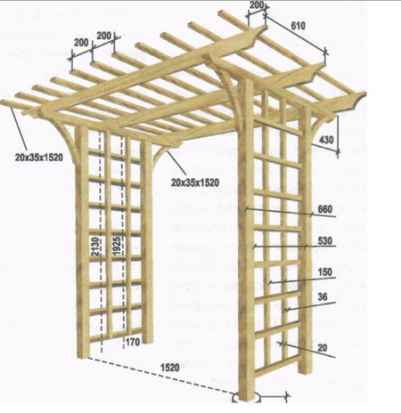

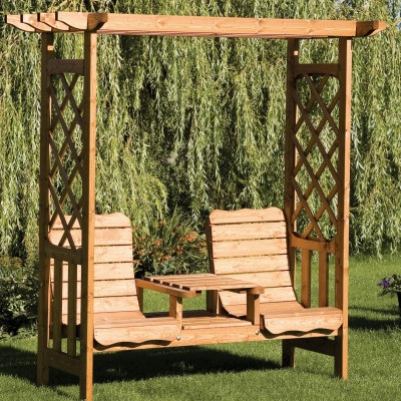
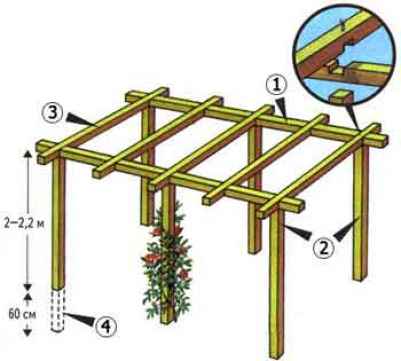
If you choose the right material and design features, you can reveal all the advantages of a particular plant. Regardless of the material, the pergola under any circumstances must look airy and light. Rigidity must also be inherent in the structure so that the severity of the plants does not lead to any damage, deformations and other problems.
It is important to choose the optimal dimensions, because too high a design looks a little unfortunate.
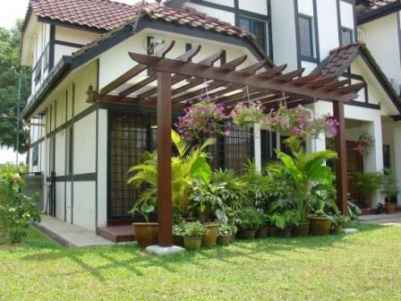
Installing a pergola in an area where children play can help protect them from potential sunstroke. The site becomes more attractive from an aesthetic point of view. Sometimes, thanks to it, you can cover other buildings that do not look very good. Zoning space can be very effective due to this design. The area, in the design of which it is inscribed harmoniously and competently, becomes more well-groomed, attractive and neat. The structure is distinguished by its aesthetics and functionality.
What is a pergola in landscape design
Home »Articles» Landscape design »What is a pergola in landscape design

What is a pergola in landscape design
It is customary to call a garden gazebo or a canopy entwined with greenery with a beautiful word pergola. This Latin name literally means "canopy" or "extension". Pergolas in landscape design, the photos of which are below, as a rule, consist of several wooden arches connected by bars, often their design resembles a grid. This structure can be either an independent element of the site design, or be part of the terrace.
What is a pergola for?

- Serve as a support for climbing plants, such as grapes;
- Create a cozy shady place protected from the sun's rays;
- Divide the site into different zones;
- Mask objects out of harmony (outbuildings);
- Decorate the entrance to the site.
It is worth remembering that even a pergola gazebo, densely entwined with greenery, can only provide protection from the sun, but not from rain, so it will not be suitable for use in bad weather.
What are the pergolas
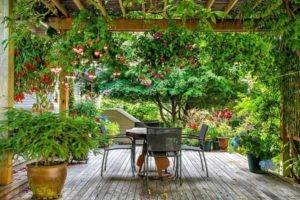
- Location. There are wall-mounted pergolas to create a patio, as well as free-standing pergolas that look more like garden gazebos.
- Functionality. There are pergolas-awnings for creating a canopy over a car or a playground, canopies to protect windows from the sun's rays, pergolas-screens for dividing the territory into zones, garden gazebos, pergolas-tunnels for shading and decorating garden paths.
- Style. The pergola can be designed in any style of landscape design: country, modem, hi-tech, etc.
- Design. It can be light or massive, small or large, linear or arched.
- The form. It can be round, square, broken.
- Material. Most often, pergolas are made of wood, less often they are forged from metal.The structure can be made of plastic and even made of bricks. The latter option looks solid and massive, so it will be appropriate only in a spacious area. A combination of several materials in one design is possible.
How to choose a pergola
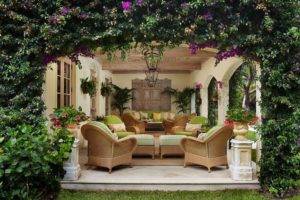
First of all, you should decide on the material for the structure:
- The classic version of wood is inexpensive and will be combined with almost any design. We recommend that you opt for such species as pine, spruce, and, of course, noble oak.
- The forged structure looks more romantic, but it will cost more than a wooden one;
- Plastic is an inexpensive material with high functionality, but it will not be appropriate in any style, although you can try to completely hide the plastic base under the vines.
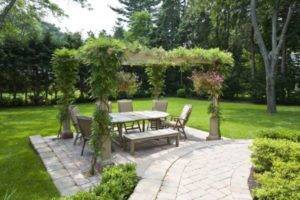

Selection of climbing plants
In order for the greenery on the canopy to be uniform and beautiful, you should select plants with the same development periods. They will grow at the same pace and over time will cover the support with an even layer of shoots and foliage. But you should not use more than three types of plants for landscaping, otherwise the object will stand out too much against the surrounding background. Remember also that all plants must be adapted to the climatic zone of Kazan.
Hop

Of course, this is not a complete list of climbing plants that can be used to braid a pergola. Ivy, actinidia, morning glory, sweet peas and other plants are suitable for this purpose.
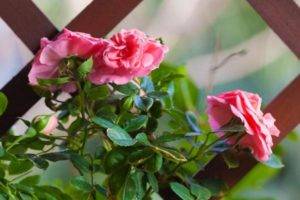 Climbing rose
Climbing rose
The queen of the garden will not leave anyone indifferent. There are varieties of roses that are suitable for vertical gardening, they form shoots up to 15 meters long. Relaxing under the shade of such a pergola, you will enjoy the beautiful view of roses and their unique aroma.
Pergola care
After installing the pergola on the site, it should be cared for periodically. The actions to be taken depend on the material of the structure.
- The tree must be treated against insect pests and high humidity. For this, special varnishes and paints are used.
- The metal needs to be treated against corrosion, and it is better to paint it;
- Plastic is the most resistant to negative environmental factors, it does not rust or decay, therefore, in this case, no care is required
Care is also necessary for the plants that braid the base. To form a uniform cover, excess shoots must be regularly cut off, and the necessary ones must be tied up so that they grow in the right direction.
Conclusion
A garden pergola can be a great decoration for a site in any style. Thanks to the variety of existing designs, it is possible to fit a green canopy into any landscape design project. In a cozy partial shade created by the shoots of climbing plants, you can spend time with your family or friends, feeling the unity with nature and enjoying life outside the city.
